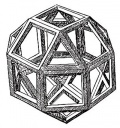Charles Eames
From The Art and Popular Culture Encyclopedia
|
Related e |
|
Featured: |
Charles Eames (1907 – 1978) was an American designer, architect and filmmaker who, together with his wife Ray, is responsible for many classic, iconic designs of the 20th century.
Designers
In the 1950s, the Eameses continued their work in architecture and modern furniture design. Like in the earlier moulded plywood work, the Eameses pioneered innovative technologies, such as the fiberglass, plastic resin chairs and the wire mesh chairs designed for Herman Miller. Charles and Ray would soon channel Charles' interest in photography into the production of short films. From their first film, the unfinished Traveling Boy (1950), to the extraordinary Powers of Ten (1977), their cinematic work was an outlet for ideas, a vehicle for experimentation and education.
The Eameses also conceived and designed a number of landmark exhibitions. The first of these, Mathematica: a world of numbers...and beyond (1961), was sponsored by IBM, and is the only one of their exhibitions still extant. The Mathematica Exhibition is still considered a model for scientific popularization exhibitions. It was followed by "A Computer Perspective: Background to the Computer Age" (1971) and "The World of Franklin and Jefferson" (1975-1977), among others.
The office of Charles and Ray Eames, which functioned for more than four decades (1943-88) at 901 Washington Boulevard in Venice, California, included in its staff, at one time of another, a number of remarkable designers, like Henry Beer and Richard Foy, now Co-chairmen of CommArts, Inc., Don Albinson, Deborah Sussman, Harry Bertoia, and Gregory Ain, who was Chief Engineer for the Eames' during World War II. Among the many important designs originating there are the molded-plywood DCW (Dining Chair Wood) and DCM (Dining Chair Metal with a plywood seat) (1945), Eames Lounge Chair (1956), the Aluminum Group furniture (1958) and as well as the Eames Chaise (1968), designed for Charles's friend, film director Billy Wilder, the playful Do-Nothing Machine (1957), an early solar energy experiment, and a number of toys.
Short films produced by the couple often document their interests in collecting toys and cultural artifacts on their travels. The films also record the process of hanging their exhibits or producing classic furniture designs, to the purposefully mundane topic of filming soap suds moving over the pavement of a parking lot. Perhaps their most popular movie, "Powers of Ten" (narrated by the late physicist Philip Morrison), gives a dramatic demonstration of orders of magnitude by visually zooming away from the earth to the edge of the universe, and then microscopically zooming into the nucleus of a carbon atom. Charles was a prolific photographer as well with thousands of images of their furniture, exhibits and collections, and now a part of the Library of Congress.
Charles Eames died of a heart attack on August 21, 1978 while on a consulting trip in his native Saint Louis, and now has a star on the St. Louis Walk of Fame. Ray died 10 years later to the exact day.
At the time of his death they were working on what became their last production, the Eames Sofa which went into production in 1984.
From the beginning, The Eames furniture has usually been listed as by Charles Eames; indeed in the 1948 and 1952 Herman Miller bound catalogs, only Charles' name is listed, but it's become clear that Ray was deeply involved and should be considered an equal partner. The Eames fabrics (many are currently available from Maharam were mostly designed by Ray, as were the Time Life Stools. But in reading the various books on Eames, and seeing the photos of furniture developement, it's clear that Ray's involvement is absolute.
Strike-through text

